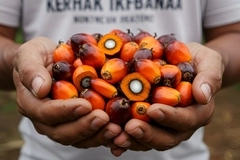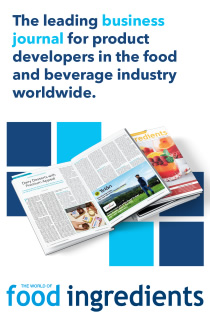Future-proofing fats: Taste, traceability and tech drive innovations amid health, cost and climate pressures

Edible fats and oils innovations are increasingly driven by health-conscious consumers and climate-aware markets, leading to a shift toward cleaner labels, better nutrition, and sustainable sourcing. From reducing saturated fats to adopting regenerative agriculture and exploring substitutes — manufacturers are retooling their strategies to deliver on performance, taste, and responsibility.
An integral component of cooking and diets globally, fats and oil provide versatility and flavor enhancement in foods. While they remain a dietary staple, consumer preferences for oil products are constantly evolving, with nearly 40% of consumers globally saying that rich flavor or taste makes the F&B experience “impressive,” indicates Innova Market Insights data.
Food Ingredients First speaks with Uelzena Ingredients, AAK, and Cargill to understand how companies are trying to solve the “complex puzzle” of balancing stability and texture of fats with sensory experience, while reformulating to appeal to consumers’ taste buds.
“The edible oils and fats industry is influenced by consumers who prioritize transparency, sustainability, and culinary experiences. Our research has identified four key cultural drivers: ‘unlock time and money,’ ‘treasure planet,’ ‘proactive health & wellness,’ and ‘experience & attention economy,’” says Marieke Otten, head of Insights & Strategic Marketing at AAK.
 Milk fat offers rich flavor, nutrition, and functionality unmatched by many vegetable fats and margarines, says Brand.Financial pressure is urging consumers to prefer options that save time and effort while being economically appealing. They are also increasingly concerned about environmental issues and make purchasing decisions based on companies’ sustainability practices.
Milk fat offers rich flavor, nutrition, and functionality unmatched by many vegetable fats and margarines, says Brand.Financial pressure is urging consumers to prefer options that save time and effort while being economically appealing. They are also increasingly concerned about environmental issues and make purchasing decisions based on companies’ sustainability practices.
“There is a shift from a product-based economy to an experience and attention economy, where consumers value the impact of products and services on their lives.”
For Anja Brand, brand manager at Uelzena Ingredients, sustainability, and clean labeling are continuing trends.
“Consumers want natural, minimally processed products without artificial additives. Butter and concentrated butter naturally fulfill these requirements. Especially when they come from sustainable regional dairy farming.”
Reconsidering dairy fats
Brand continues that milk fats give foods a distinctive, natural flavor that is “difficult to imitate with margarine or vegetable fats.”
“I would like to dispute the old prejudice that vegetable oils and fats are generally better or healthier than dairy fats. Butter and butterfat are only minimally processed and do not require any chemical hardening or emulsifiers, as is often the case with margarine,” she asserts.
“They contain no artificial additives and only very few natural trans fats, which are often a problem with hydrogenated vegetable fats.”
Milk fats In the UK, scrutiny of fats has eased since 2019, but health claims like ‘no saturated fat’ still strongly influence buying choices. consist of a balanced mixture of saturated, monounsaturated, and polyunsaturated fatty acids and provide vitamins A, D, E, and K, which are often “not naturally present in vegetable fats, and are instead added separately.”
In the UK, scrutiny of fats has eased since 2019, but health claims like ‘no saturated fat’ still strongly influence buying choices. consist of a balanced mixture of saturated, monounsaturated, and polyunsaturated fatty acids and provide vitamins A, D, E, and K, which are often “not naturally present in vegetable fats, and are instead added separately.”
“The mouthfeel and melting behavior of milk fats also stand out positively, and the difference is particularly noticeable in chocolate or baked goods.”
“In the production of baked goods, milk fats also ensure a better dough structure, a finer flavor, and optimum browning. They also have good emulsifying properties and produce more stable emulsions than many vegetable alternatives when making sauces and cream fillings,” she explains.
Bakery (22%) is a dominant category using oils as ingredients, followed by confectionery (14%), snacks (14%) and ready meals and side dishes (10%), suggests Innova Market Insights data.
Rise of “ingredient-seeking” behavior
Cargill’s 2024 FATitudes consumer research revealed that while consumers are increasingly looking for more nutritional options with reduced saturated fats or oils perceived as more natural — they are “not willing to compromise on taste and texture,” Cornelia Schaffrath, Cargill’s Edible Oils Europe product line director, tells us.
“For example, in the UK, scrutiny around fats and oils in packaged foods has declined since its peak in 2019, but health-driven claims like ‘no saturated fat’ remain highly influential in purchasing decisions.”
French and German consumers increasingly prefer oils linked to positive health benefits, particularly Omega-3 fatty acids and monounsaturated fats.
 European consumers seek Omega-3 and plant-based oils in health choices the most, says Schaffrath.Schaffrath also asserts that Cargill’s TrendTracker 2024 research confirms that consumer scrutiny over ingredient lists continues to shape purchasing decisions.
European consumers seek Omega-3 and plant-based oils in health choices the most, says Schaffrath.Schaffrath also asserts that Cargill’s TrendTracker 2024 research confirms that consumer scrutiny over ingredient lists continues to shape purchasing decisions.
“Ingredient avoidance trends remain strong, particularly regarding fats and oils, with 40% of global product launches now including low/no/reduced fat claims. However, ingredient-seeking behavior is also on the rise, with Omega-3 and plant-based oils ranking among the top health-driven choices in Europe.”
Navigating cost, regulation, and consumer shifts
Lucas Hardy, head of the Innovation Center of Excellence at AAK, highlights scarce resource management, consumer confidence and spending power, and the “continual introduction of new regulations” as the multiple drivers of change impacting the edible oils industry today.
“We also know we cannot overcome these challenges ourselves and are active in a number of initiatives. We are a corporate member of the European Institute of Innovation & Technology Food Accelerator Network and Food Bioprocessing Hub focussed on increasing the role of biotech in food manufacture.”
Schaffrath adds that the industry is also grappling with price volatility and raw material availability.
 Consumers value the impact of products on their lives, indicating a shift toward an experience and attention economy, says Otten.“The edible oils supply chain has been under pressure from geopolitical shifts, climate variability, and economic uncertainty, all of which have contributed to fluctuating costs and supply constraints. Managing these disruptions requires a combination of supply chain agility, sustainability programs, and close collaboration with customers to ensure reliable sourcing and stable pricing.”
Consumers value the impact of products on their lives, indicating a shift toward an experience and attention economy, says Otten.“The edible oils supply chain has been under pressure from geopolitical shifts, climate variability, and economic uncertainty, all of which have contributed to fluctuating costs and supply constraints. Managing these disruptions requires a combination of supply chain agility, sustainability programs, and close collaboration with customers to ensure reliable sourcing and stable pricing.”
“TrendTracker 2024 highlights that 76% of European consumers cite the cost-of-living crisis as a major concern, influencing how they select food products. As a result, there is a heightened demand for value-driven solutions, including affordable and sustainable alternatives in the oils and fats category,” she adds.
Advancing sustainability
AAK’s head of R&D Kim Olofsson tells us that the company recently installed new bio-boilers at its Aarhus site in Denmark to reduce CO2 emissions by 50,000 metric tons annually, for a 90% reduction in scope 1 and 2 emissions for the site.
The plant-based oil and fat supplier along with Lund University, has also received a grant from the Swedish Foundation to research the feasibility of replacing organic solvents used in oil production with “green and sustainable supercritical CO2 in the factories.”
Meanwhile, Cargill has turned to Responsibly Sourced Palm Oil-certified palm products in Europe, alongside sustainable coconut, rapeseed and high oleic sunflower oils to provide its customers with products that are fully traceable to sustainable sources, shares Schaffrath.
 AAK’s new bio-boilers in Aarhus cut CO2 emissions by 50,000 tons annually (Image credit: AAK).“Beyond palm oil, we are also investing in regenerative agriculture through our Cargill RegenConnect program. This initiative partners with farmers to implement regenerative practices for crops like soy, canola, and sunflower.
AAK’s new bio-boilers in Aarhus cut CO2 emissions by 50,000 tons annually (Image credit: AAK).“Beyond palm oil, we are also investing in regenerative agriculture through our Cargill RegenConnect program. This initiative partners with farmers to implement regenerative practices for crops like soy, canola, and sunflower.
Replacing palm oil
Uelzena develops customized fat components with specific functional and nutritional properties, says Brand.
“The addition of high-melting butterfat fractions to butter, for example, ensures better plasticity and heat resistance compared to normal butter, which makes it easier to process. This specialty butter is ideal for applications such as puff pastry, croissants and chocolate, as it improves the structure and texture.”
“However, high-melting milk fat fractions could also help in the reformulation of products to replace palm oil or other hydrogenated fats. By replacing hydrogenated fats or palm oil, we facilitate a consumer-friendly declaration,” she notes.
The low-melting fractions can improve butter’s creaminess and spreadability, facilitating dosing and incorporation into the products.
Exploring alternatives
In the future, Brand expects butterfat to become more important as a “natural alternative to hydrogenated fats or palm fat, which has been particularly criticized.”
“And even if a plant-based diet is currently the trend, there is also a growing countermovement toward full-fat, animal products (e.g. keto and low-carb diets). In Asia and other growth markets, demand for dairy fats is also increasing, particularly as an alternative to vegetable oils.”
She believes countries such as China and India offer the potential for butterfat products, as the popularity of Western nutrition is increasing in these regions.
For AAK’s Olofsson, “alternative and novel oils, such as microbial or lab-grown fats,” are expected to play a significant role in the future of the edible oils industry.
“These innovations offer sustainable and renewable options that can replace traditional animal-based fats, contributing to important food functionality and a more sustainable and environmentally friendly food system.”

















